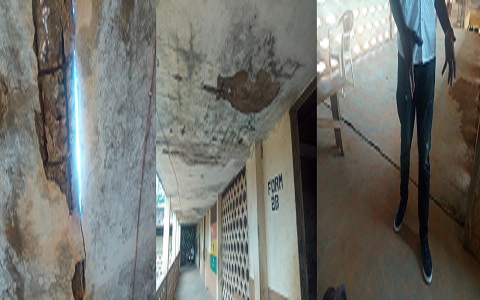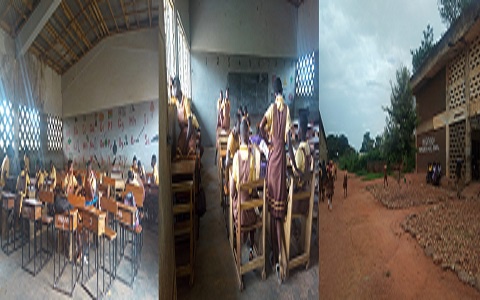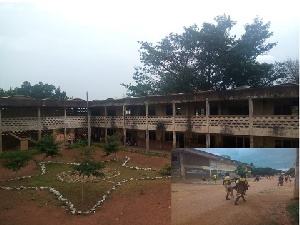An emergency evacuation of over 600 school children has taken place at the Bolgatanga Preparatory Model Junior High School (JHS) following a strong alarm from architects that a decomposing single-storey building which houses the pupils is about to fall.
The school, which is to the Upper East region what Achimota School is to the Greater Accra region, has produced an unmatched number of individuals who have become fabulously successful across the globe but have failed to support a grieving alma mater successive governments have forsaken.
So close is the anticipated collapse that the Bolgatanga Municipal Assembly (BMA) has issued a very strict order to the Ghana Education Service (GES) in the regional capital to keep the gates to the building firmly and indefinitely locked so no person returns there to be trapped inside the rubble when the peeling pillars finally give way.
Evacuated pupils looked displaced and teachers appeared disorganised when Starr News visited them after their relocation to the surrounding schools for safety.
Some of the juvenile evacuees now take their lessons inside classrooms meant for preschoolers at an adjoining kindergarten school. Others have been moved temporarily to the Zaare Experimental JHS, a school within the vicinity.
Meanwhile, a reported half of some 132 pupils, who joined the school just this academic year, have been withdrawn by their parents and guardians to schools elsewhere in the wake of the alarm and the displacement.

“The building is going to fall. That is why they brought us here,” said Yussif Abubakari, one of JHS 3 pupils who have been relocated to a kindergarten classroom. “We are not comfortable here. But here is better than where we were. We used to panic inside the former building anytime it rained thinking a thunder would just finish the job and the building would collapse on all of us.”
Only one former student, 32-year-old Gamel Akane, is known to be practically concerned about the state of the school. He donated teaching and learning resources to the school in 2017, provided mathematical instruments for all Basic Education Certificate Examination (BECE) candidates that year and, whilst presenting the items, spoke passionately about his plans to mobilise some alumni to seal the cracks in the building themselves without waiting on government.
The fall of paradise
The school’s current situation is a total contrast to how things used to be when it all started as a primary school more than a few decades ago.
It was the only public basic school for children from families of status and wealth in the north. At a time there was no private school in the region and the public schools that existed had nothing, Preparatory (as it is called in short) had everything.
Some schools were too poor to hire a bicycle, let alone own a motorbike or a car; Preparatory, aside from its affluent parents driving their children to the school in the morning on plush private vehicles and returning in the afternoon to drive them back home, also had a standby bus for the pupils.
At the time schoolchildren stood under trees to dine at some schools and they answered to the call of nature in the open for lack of a toilet facility, Preparatory had a truly convenient place of convenience for the children and it was the only basic school with a dining hall in the region.
And with a conference room, a well-equipped play park and a football field for the children, the “Prestigious Preparatory” was a “Paradise” for “Privileged Pupils”.

And so it was… until some members of the host community, Zaare, and natives from some surrounding villages, who were upset that the authorities at the school were denying needy children enrollment by asking their admission-seeking poor parents to satisfy some conditions they could not meet, protested what they described as “baseless discrimination”.
The protests were followed in the early 1980s by an unforgettable revolt that eventually saw the gates unlocked to allow in all children regardless of their backgrounds— rich or poor— and the statuses of their parents or guardians— a porter or a top public servant.
Those who criticised the revolt still believe some excesses led to the fall and decay of the school. But some have continued to appreciate the change, dubbing it the fall of a ‘partisan paradise’ and the rise of a ‘dreamland devoid of disdain for the deprived’.
Today, the school, whose buildings once resonated with ceaseless chit-chats of happy kids, has moved from “treasure” to “trash” with only echoes of grief from panic-stricken children being heard from there. It used to be the most captivating realm in the host community. But, standing today in hopeless ruins in the midst of many impressive buildings that have overtaken it, the school now looks like a cancer that has refused to heal in the foot of a gifted community who is rubbing shoulders with peers in an ‘Olympic race’ for development.
It was the pride of the area. But now, it is their pain. The ‘fall of paradise’— a fall a popular opinion leader in the community, Noble Asakeya Alagskomah, blames on what he calls “a lucid case of lack of maintenance culture in most public facilities after Nkrumah’s Administration”.
“We are now a mobile school”— Frustrated teachers
The near-collapse building looks like a spare structure which has been used for a rehearsal by a military squad on an airstrike mission.
The inner sides of all graffiti-stained 17 classrooms in the building are showing deep cracks, with rusty iron rods in the pillars exposed everywhere.
There is a split to the east of the concrete roof, so wide the sky can be seen so clear through it. And to the west at the top floor is a crumbling pillar, each bit that drops from the aged pillar to the multi-cracked floor generously reminding distressed observers of the countdown to the foretold collapse.

Whenever it rains, water from the gaping fractures and holes in the concrete roof floods the building from top down. Eyes that look into the dim classrooms are met with sagging ceilings periodically colonised by bats and windows that ‘hand over’ the pupils to a reckless rain splash because the louvres are all gone like the dinosaurs.
“Our school is now called a mobile school,” said one of the frustrated-looking teachers who, in the aftermath of the emergency evacuation, now sit without shelter in front of the gates to the building as their staff common room.
“The children are scattered. And as subject teachers, we now move from one school to the other, where our pupils have been separately relocated, to teach them. We are a mobile school now,” he explained, dabbing his moist forehead in the sun.
Efforts to get the Municipal Chief Executive (MCE) for Bolgatanga, Joseph Amiyuure, Saturday to speak to the crisis failed as he did not answer telephone calls from Starr News. Engineers at the assembly, according to the Assemblyman for Zaare East, Jacob Ayuusah, are not certain yet what to do on the collapsing building.
“I was at the assembly last Thursday. The assembly engineers said they wanted to involve the AESL (Architectural and Engineering Services Ltd) and go back to the school to know whether after a renovation has been done, the school can be safe, or they should just demolish it and rebuild,” Mr. Ayuusah told Starr News.
Regional News of Sunday, 16 September 2018
Source: starrfmonline.com

















